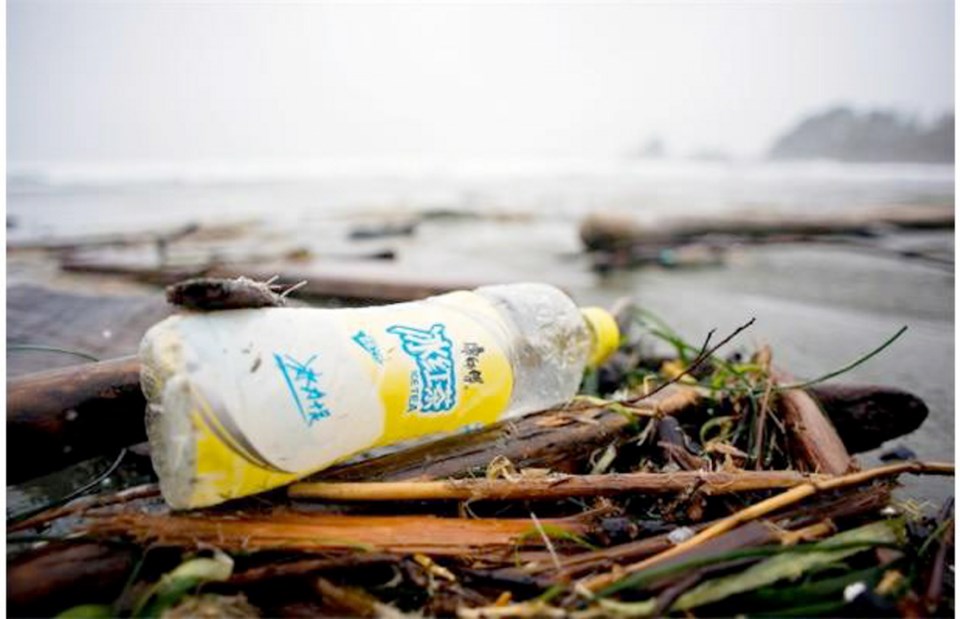As the leaves fall, many Canadian families recall terrific memories from the summer spent on Canada’s coasts. But for some, these memories will be tainted by a troubling realization: Contrary to its reputation for pristine waters and abundant wildlife, we are facing a serious and growing problem of plastic pollution on our coast.
Toward the end of August, residents of one island just north of Vancouver got together for their second beach cleanup in as many years. Over those two years, two tonnes of garbage have been pulled off about six kilometres of shoreline. Easily the biggest category of waste is Styrofoam, but hard plastic and car tires also wash up frequently. The provenance of the waste is hard to establish, but the size of the debris suggests that a large part comes from industrial activities, fisheries or private docks that were washed away in harsh weather.
Once onshore, the combination of winter storms and logs on the beaches grind down the foam into small pieces. In some coves with the right exposure, you sink into holes several feet deep and they are filled with bits of foam. Plenty of these spots are left on our six-kilometre stretch of island coastline that has seen a first round of cleaning up. A lot of this microplastic makes its way back into the ocean.
This is when plastic becomes a serious threat to wildlife. Microplastic gets ingested by plankton, or by small fish that feed on plankton and cannot tell the difference between plankton and plastic particles. From there, the plastic works its way up the food chain. Research done at the Scripps Institute of Oceanography at the University of California estimates that fish eat about 12,000 to 24,000 tons of plastic each year in the Pacific alone. Like it or not, that delicious steak of Pacific salmon on your plate contains plastic, too.
Filter-feeders such as clams or oysters represent another important group of victims from plastic pollution. They filter more than a litre of seawater per hour. In some places such as Squamish, we now measure up to 20 pieces of microplastic per litre. The cumulative effect is devastating. Finally, think of the pictures that have become all too common of dead sea birds, whose stomachs contain a whole array of plastic waste.
A more fundamental worry still lies in this pollution shutting down the ocean’s capacity to produce oxygen. Destabilizing the fragile ecosystem of the ocean could lead to a loss of the algae that account for a substantial proportion of the world’s oxygen production. As Margaret Atwood has succinctly commented in regard to the plague of plastic: “Dead oceans mean dead people.”
More and more grassroots initiatives to clean up the oceans are being launched. This year, the waste cleaned up on our island did not end up in landfills; instead it is being processed by Ocean Legacy, a not-for-profit foundation based in Vancouver. Its goal, in addition to organizing cleanups all over the West Coast, is to recycle the plastic into various uses, including a promising plastic-to-fuel program that is being tested.
Another NGO, the Ocean Cleanup, is working on the technology to siphon plastic out of the enormous gyres that circle way out in the oceans. Greenpeace has also launched an ocean plastics campaign.
Let’s be realistic: This problem has become too big to solve through civil-society efforts and the goodwill of an army of volunteers alone. Volunteers are desperately needed and coming forth in ever bigger numbers. But they need help from politicians at all levels of government.
Providing funding and logistics for cleanups is a start. How about a federally or provincially funded program for young Canadians to clean up the coast during the summer? How about the Canadian government joining initiatives such as the Ocean Cleanup, as the Dutch government has done?
Perhaps even more important than supporting the cleanup is the effort to reduce the mess in the first place. We need to change our attitude toward plastic consumption and toward our way of disposing of it.
Governments must pull all the levers available to them: We need educational programs to raise awareness of the problem, to convince Canadians to consume less plastic and to dispose of it responsibly; we need positive financial incentives, including higher taxes on oil, for the development of alternatives to plastic or biodegradable forms of it; we need negative financial incentives in the form of fines for the worst polluters; and, in some cases, we need legislation to do without plastic altogether. Both shopping bags and coffee cup lids fall into this category.
Changing well-entrenched patterns of consumption and production will not be straightforward. It will take a concerted effort to make sure future generations of Canadians will be able to enjoy the natural diversity of our coastline in years to come.
Peter Dietsch, PhD, is a professor at Université de Montréal.



